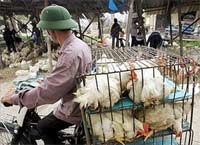Recent news reports on avian influenza have made readers acutely aware of the urgency and determination of governments worldwide, from the USA, UK, France, Sweden, Croatia, Russia, India, to Thailand, in dealing with the impending pandemic.
The death of a parakeet infected with the H5 virus in a quarantine room has caused a stir in the UK’s healthcare system. The death of a swan was enough for the Croatian Ministry of Agriculture to announce the culling of all poultry within a 3 km radius to prevent avian influenza. Additionally, the visits made by the U.S. Secretary of Health to various Asian countries and the $38 million aid package to Vietnam, Laos, and Cambodia for enhancing surveillance, testing, and training in avian influenza show that the U.S. is taking proactive measures.
Countries around the world are pressuring the Swiss pharmaceutical company Roche, the holder of the Tamiflu patent, to lift its monopoly and grant licenses to other companies to produce cheaper versions of the medication. In a display of prioritizing public health, Taiwan has declared it will manufacture Tamiflu independently, without waiting for Roche’s approval. The tension over stockpiling antiviral medications has spread globally.
Meanwhile, experts from the World Health Organization (WHO) have continuously issued warnings about a potential avian influenza pandemic that could spread worldwide, with the potential to claim millions of lives. Southeast Asia, considered the origin of the pandemic and the region with the least attention to prevention measures, is expected to bear the brunt of the consequences.
 Looking back at Vietnam, while the world is in a frenzy over the increasingly complex developments of avian influenza, the Vietnamese people appear to be “indifferent” to this epidemic. This “insensitivity” is quite evident in the media: daily news reports are filled with information about avian influenza globally, yet it takes a keen eye to find any news about avian influenza in Vietnam!
Looking back at Vietnam, while the world is in a frenzy over the increasingly complex developments of avian influenza, the Vietnamese people appear to be “indifferent” to this epidemic. This “insensitivity” is quite evident in the media: daily news reports are filled with information about avian influenza globally, yet it takes a keen eye to find any news about avian influenza in Vietnam!
This outbreak of avian influenza is causing global concern because the issue at hand is not merely the death of poultry as often thought, but the potential loss of human lives. The World Health Organization (WHO) recommends that each country stockpile enough antiviral medication and vaccines for at least 20% of its population, which translates to 20 million people for Vietnam.
How many doses of medication has the Ministry of Health stockpiled to counteract the epidemic if it occurs? What preparations has the Ministry of Agriculture and Rural Development made? How have relevant authorities planned proactive responses? All this information must be continuously and timely communicated to the public.
DUY HUỲNH
* The community must actively combat avian influenza
Avian influenza is gradually becoming a global threat, impacting various sectors and resulting in adverse consequences that could have a cascading effect if we do not prevent its escalation into a major outbreak.
Reports of a flock of ducks in Hong Dan District (Bac Lieu) being infected with avian influenza virus and subsequently culled, along with some farmers in Tra Vinh splitting their duck flocks to manage vaccinations, coupled with the ongoing vaccination campaigns in the Mekong Delta facing vaccine shortages, are indeed concerning.
Particularly, as many countries in Asia and Europe continuously report findings of migratory birds and domestic poultry infected with the H5N1 virus, and with cases of human fatalities due to H5N1 infections in Thailand, Indonesia, and China, the World Health Organization’s warnings about a dangerous pandemic potential only emphasize the need for vigilance and precaution as we approach the flu season – winter – which is fast approaching.
Given the fragmented and dispersed nature of livestock farming in our country, combined with challenging transportation conditions and an inadequate veterinary network, along with limited support policies, if we do not engage the entire population in this effort, the decisive guidance from the government, alongside state efforts and international support, will struggle to meet its objectives, and desired results may not be achievable.
The situation concerning disease in poultry, among humans, and the economic and social consequences of a pandemic is unpredictable. Therefore, each of us must recognize our responsibility to the community, which is also a means of protecting ourselves, our families, and our loved ones; we must strictly adhere to local veterinary regulations regarding vaccination, ensuring that all doses are administered on schedule without missing any individuals that require vaccination. We must refrain from transporting, selling, slaughtering, or consuming poultry and eggs during the designated safe isolation period post-vaccination as mandated.
At the same time, we must collectively promote awareness and encourage those around us to comply and take action as we do, contributing to a national effort to effectively prevent the resurgence of this epidemic, and to support the international community in eradicating this dangerous disease, restoring normal life for many.
There are numerous challenges facing the veterinary sector, particularly in vaccination efforts, followed by monitoring and quarantine processes in slaughtering, trading, and transportation, which are already complex and ongoing. If individuals involved with poultry products, eggs, breeding stock, feed, etc., lack vigilance and do not comply with any part of the veterinary regulations regarding H5N1 avian influenza specifically, and other diseases in general, then executing the action plans directed by the government will be very difficult, and adverse outcomes will be hard to avoid.
Thus, beyond the efforts of the veterinary sector, it is essential for all government levels and the community to provide more active support. Particularly, we must work together to promote awareness and encourage farmers to understand their responsibilities amidst this common threat, and to actively participate in vaccinating poultry.
In the immediate future, as the risk of avian influenza looms, farmers should consider diversifying livestock rather than continuing to raise poultry (including waterfowl). They should collectively halt poultry farming on a wide scale to ensure a minimum isolation period of several cycles; only when the disease is genuinely stabilized should they plan carefully regarding breeding, techniques, and ensuring safe stocks and sufficient vaccines before resuming farming to avoid losses.
KS. NGUYỄN VĂN THƯỚC (Department of Science, Ca Mau)




















































